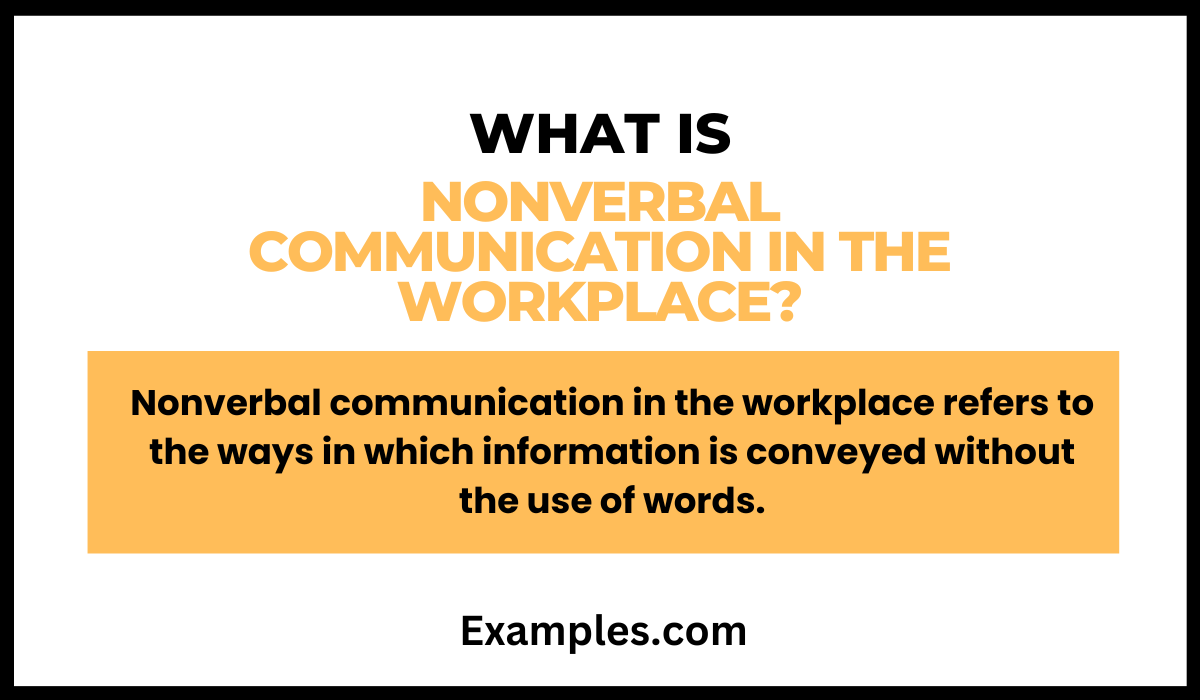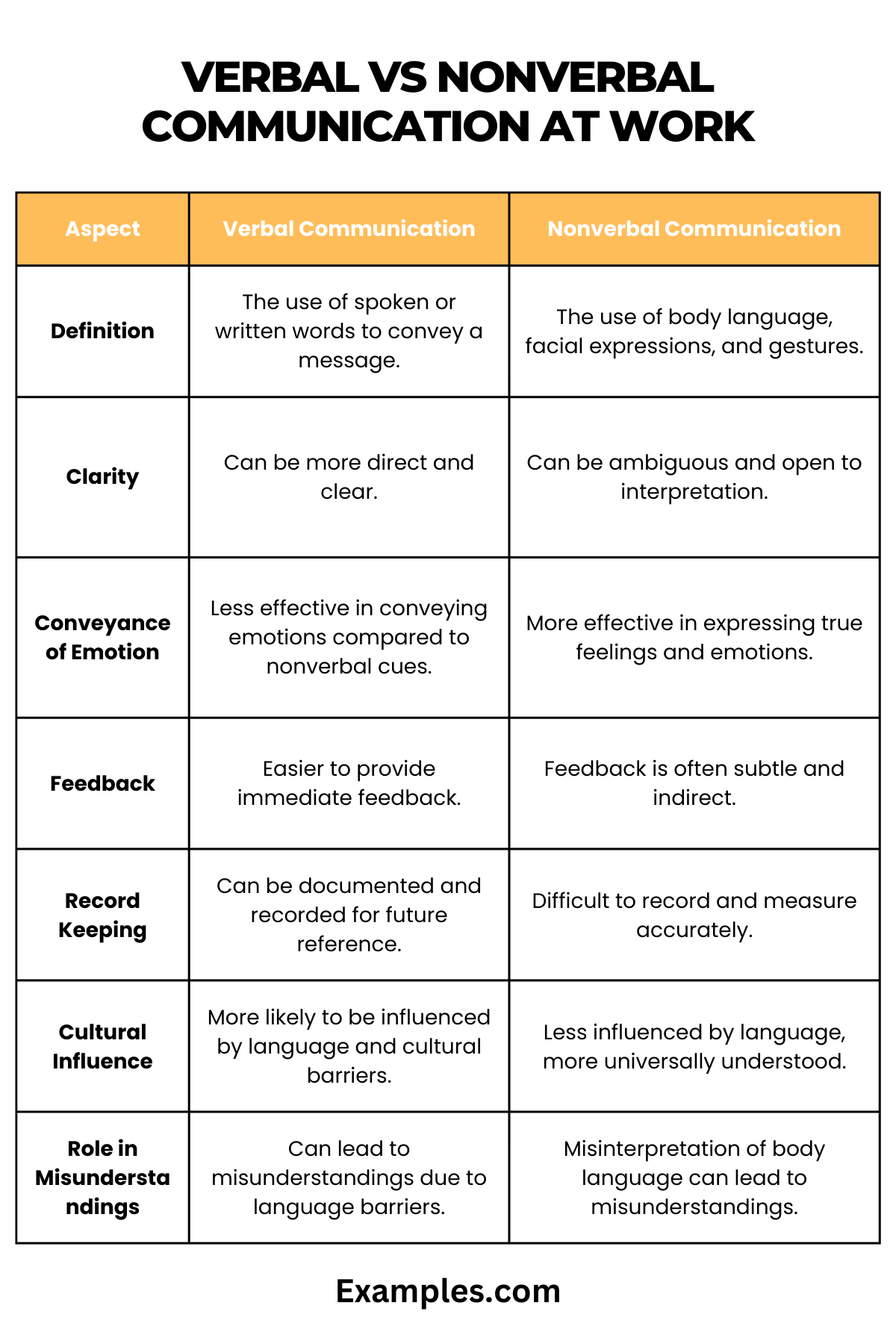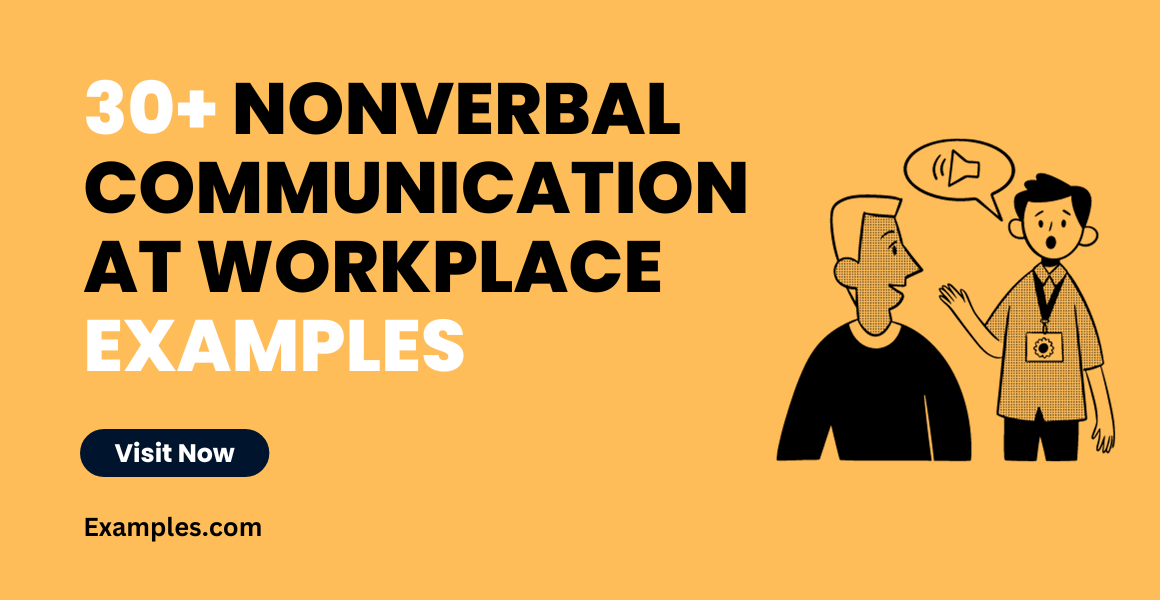29+ Nonverbal Communication at Workplace Examples
Unlock the secrets of effective workplace interactions with our complete guide on nonverbal communication at the workplace. Packed with insightful nonverbal communication examples, this resource is tailored to help you understand and harness the power of unspoken cues. Learn to read body language, interpret gestures, and apply these skills to enhance your professional interactions. Perfect for anyone looking to improve their communication prowess, this guide is an indispensable tool for navigating the complex dynamics of today’s work environments.
What is Nonverbal Communication in the Workplace?
Nonverbal communication in the workplace refers to the ways in which information is conveyed without the use of words. This can include body language, facial expressions, gestures, posture, and even the use of physical space. In a professional setting, these nonverbal cues are crucial as they can complement, reinforce, or sometimes contradict what is being said verbally. Understanding and correctly interpreting these signals can significantly enhance interpersonal relations and effectiveness in the workplace.

30+ Examples of Nonverbal Communication in the Workplace
In the realm of effective workplace dynamics, understanding nonverbal communication is pivotal. This guide illuminates various nonverbal communication examples, offering insight into their impact and application in professional settings. From the subtle nuances of body language to the more overt gestures, these examples highlight how nonverbal cues can enhance or undermine verbal interactions. Mastering these skills not only improves interpersonal relations but also bolsters nonverbal communication skills crucial for career advancement. Here are 30 distinct examples, each with a practical application, to help you navigate the complex landscape of nonverbal communication in daily life, including in specialized fields like nursing and teaching.
- Maintaining Eye Contact: Signifies focus and sincerity.
Example: “In meetings, steady eye contact shows you are actively listening and engaged in the discussion.” - Nodding: Indicates agreement or comprehension.
Example: “Nodding during a presentation demonstrates your understanding and approval of the points being made.” - Smiling: Reflects approachability and positivity.
Example: “A warm smile to colleagues can create a friendly and welcoming work environment.” - Crossed Arms: May suggest defensiveness.
Example: “To appear open and receptive, avoid crossing your arms during team discussions.” - Leaning In: Shows engagement and interest.
Example: “Leaning in slightly during a one-on-one signifies your active involvement in the conversation.” - Fidgeting: Can indicate nervousness or distraction.
Example: “Maintain a calm demeanor by minimizing fidgeting during important meetings.” - Hand Gestures: Enhance verbal communication.
Example: “Use hand gestures to emphasize key points in your presentation.” - Firm Handshake: Conveys confidence.
Example: “A firm handshake when meeting new clients demonstrates professionalism and self-assurance.” - Mirroring: Builds rapport.
Example: “Mirroring a colleague’s posture subtly can enhance connection and understanding.” - Raised Eyebrows: Express surprise or inquiry.
Example: “Raised eyebrows can signal your curiosity about a new project idea.” - Tapping Feet: Suggests impatience or anxiety.
Example: “Keep your feet still to convey patience during team brainstorming sessions.” - Respecting Personal Space: Fosters comfort.
Example: “Be mindful of personal space boundaries to maintain a comfortable working environment.” - Head Tilting: Indicates thoughtfulness.
Example: “Tilting your head during a discussion shows you’re contemplating the points raised.” - Eye Rolling: Shows disagreement or disdain.
Example: “Avoid eye rolling in professional settings to maintain a respectful tone.” - Pursed Lips: Can indicate skepticism.
Example: “Be conscious of your expressions, like pursed lips, during negotiations.” - Clasping Hands: Demonstrates control or assurance.
Example: “Clasping your hands while speaking can project confidence.” - Yawning: Signifies boredom or fatigue.
Example: “Manage your expressions, avoiding yawning, to show engagement in meetings.” - Drumming Fingers: Implicates restlessness.
Example: “Refrain from drumming your fingers to maintain a professional demeanor.” - Adjusting Clothing: May show discomfort.
Example: “Limit adjusting your attire to project confidence during presentations.” - Frequent Blinking: Indicates stress or discomfort.
Example: “Control blinking to appear calm and collected in challenging situations.” - Sighing: Reflects frustration or relief.
Example: “Use sighs sparingly to avoid misinterpretation in a professional setting.” - Slouched Posture: Suggests disinterest.
Example: “Maintain an upright posture to demonstrate attentiveness and enthusiasm.” - Pointing Finger: Can be perceived as aggressive.
Example: “Use gentler hand motions instead of pointing to foster a collaborative atmosphere.” - Widening Eyes: Denotes surprise.
Example: “Manage your facial expressions, like widening eyes, in unexpected scenarios.” - Hands in Pockets: May appear informal.
Example: “Keep your hands out of pockets in formal business interactions.” - Touching Face: Signals contemplation or uncertainty.
Example: “Minimize face touching to convey decisiveness and clarity.” - Biting Lips: Reflects anxiety.
Example: “Avoid lip biting in stressful situations to maintain a composed appearance.” - Steepling Fingers: Shows authority.
Example: “Use steepling fingers judiciously to assert confidence without appearing overbearing.” - Crossed Legs: Might indicate defensiveness.
Example: “Adopt open body language to appear more accessible and engaging.” - Rapid Talking: Signifies excitement or nervousness.
Example: “Control your pace of speech for clear and effective communication.”
Tips to Improve Nonverbal Interactions in the Workplace
Effective nonverbal communication is vital for successful interactions in the workplace. These tips, along with introductions, examples, and tips, focus on enhancing nonverbal skills such as body language, facial expressions, and gestures. By mastering these techniques, professionals can improve their ability to convey messages clearly, build rapport, and create a positive work environment.
1. Master Your Hand Gestures
In the world of nonverbal communication, hand gestures are a powerful tool. They can emphasize, clarify, and even add emotion to your spoken words. Imagine you’re in a team meeting discussing the growth of your company. By using the right hand gesture at the right moment, you can make your point crystal clear.
- Example: During a team meeting, when discussing the growth of the company, use an open-hand gesture to emphasize expansion.
- Tips: Use hand gestures purposefully to emphasize points, but avoid excessive or distracting movements.
2. Monitor Your Posture
Your posture speaks volumes, often louder than words. Picture a one-on-one discussion with a colleague. The way you carry yourself—whether confidently upright or slouched—can instantly convey your level of engagement and respect for the conversation.
- Example: When in a one-on-one discussion with a colleague, maintain an upright posture to signal attentiveness and respect.
- Tips: Maintain an upright posture to appear confident and engaged. Slouching can convey disinterest.
3. Adapt Your Proximity
Sometimes, the distance between you and your conversation partner matters more than you think. In a casual chat with a coworker, maintaining a comfortable distance can set the tone for a relaxed and open exchange of ideas.
- Example: During a casual chat with a coworker, maintain a comfortable distance to ensure a relaxed atmosphere.
- Tips: Respect personal space; adjust your distance according to the context and relationship with the person.
4. Convey Active Listening
Active listening is a skill highly regarded in the workplace. Imagine you’re listening to a team member’s idea. Nods and verbal affirmations can show that you’re not just hearing the words but genuinely understanding and interested in what’s being said.
- Example: While listening to a team member’s idea, nod and use verbal cues like “I see” to indicate your understanding and interest.
- Tips: Show you are actively listening through nods and occasional verbal affirmations like “I see” or “I understand.”
5. Leverage Your Eye Contact
They say the eyes are windows to the soul, and in the workplace, they can be windows to trust and sincerity. In a negotiation with a client, maintaining the right level of eye contact can convey honesty and build a strong connection.
- Example: During a negotiation with a client, maintain consistent but not intrusive eye contact to convey sincerity.
- Tips: Maintain eye contact to establish trust and connection, but avoid staring, which can be unsettling.
6. Use Facial Expressions Mindfully
Your face can be a canvas for your emotions, but it’s essential to be mindful of the messages your expressions convey. When providing constructive feedback to an employee, your composed and encouraging facial expression can be reassuring.
- Example: When providing constructive feedback to an employee, maintain a composed and encouraging facial expression.
- Tips: Be aware of your facial expressions to align them with your message, avoiding unintentional reactions.
7. Manage Vocal Tone
The tone of your voice can make or break your message. Think about a team meeting where you need to convey enthusiasm without becoming overwhelming. Managing your vocal tone is the key to striking the right balance.
- Example: During a team meeting, modulate your voice to speak with enthusiasm without shouting to maintain a comfortable volume level.
- Tips: Adjust your tone of voice to suit the situation; avoid speaking too loudly or softly inappropriately.
8. Incorporate Mirroring
Mirroring is a subtle yet effective way to connect with colleagues. Picture a scenario where a coworker leans in while sharing an idea. By mirroring their posture, you can create a sense of camaraderie and understanding.
- Example: If a colleague leans in while sharing an idea, adopt a similar posture to convey interest during the discussion.
- Tips: Subtly mirror the body language of others to build rapport, but be mindful of not overdoing it.
9. Timing Is Key
Timing plays a pivotal role in nonverbal communication. Imagine you’re emphasizing a critical project milestone during a presentation. Using the right hand gesture at the precise moment can underscore the importance of your point.
- Example: When emphasizing a critical project milestone, use a hand gesture for emphasis at the right moment in your speech.
- Tips: Use timing effectively by syncing nonverbal cues with your spoken words to emphasize key points.
10. Cultural Sensitivity
In today’s diverse workplaces, cultural sensitivity is paramount. In a multicultural team, understanding that nonverbal cues may have different interpretations across cultures is essential. It fosters respect and inclusivity in the workplace.
- Example: In a multicultural team, acknowledge and respect that nonverbal cues may have varying interpretations across cultures.
- Tips:Respect cultural differences in nonverbal communication to avoid misunderstandings and promote inclusivity in the workplace.
Verbal vs. Nonverbal Communication at Work
Understanding the differences between verbal and nonverbal communication at work is crucial for effective interpersonal interactions. Here’s a comprehensive table comparing these two communication styles:

Effective Non-Verbal Communication in the Workplace
Enhancing non-verbal communication at the workplace can improve understanding, rapport, and create a positive environment. Here are key strategies:
- Body Language Awareness: Being aware of your body language and interpreting others’ cues is crucial. An open posture and appropriate facial expressions can enhance interactions.
- Eye Contact: Proper eye contact demonstrates engagement and sincerity. It is important to balance eye contact to avoid discomfort.
- Personal Space Respect: Respecting personal space is essential, especially considering cultural differences. Understanding these norms is vital for comfortable interactions.
- Alignment of Verbal and Nonverbal Cues: Ensure your nonverbal communication matches your verbal messages. Inconsistencies can lead to confusion or mistrust.
- Active Listening: This involves nonverbal cues like nodding and maintaining eye contact, showing that you are engaged and understand the speaker.
- Cultural Sensitivity: Being mindful of cultural differences in nonverbal communication is crucial. What is positive in one culture might be negative in another.
- Continuous Learning: Improving non-verbal communication skills is an ongoing process. Observing, learning, and adapting are essential for effective communication in diverse workplace environments.
By implementing these strategies, not only individual communication skills are enhanced, but also the overall workplace atmosphere is improved, emphasizing the importance of nonverbal communication at the workplace.
Why is Non-Verbal Communication Essential in the Workplace?
Non-verbal communication plays a critical role in the dynamics of the workplace environment. Its importance lies in the following aspects:
- Enhancing Understanding: Non-verbal cues like facial expressions, gestures, and body language often convey more than words can. They help in interpreting the true intent and feelings behind spoken words.
- Building Relationships: Effective non-verbal communication fosters trust and rapport among colleagues. A smile, a nod, or an empathetic expression can go a long way in building strong interpersonal relationships.
- Facilitating Effective Leadership: Leaders who are adept at reading and using non-verbal cues are often more successful in motivating and guiding their teams. A leader’s body language can instill confidence and command respect.
- Improving Team Dynamics: Non-verbal communication is key in team collaboration. It enhances team interaction and helps in resolving conflicts more effectively.
- Cultural Sensitivity: In diverse workplaces, non-verbal communication becomes even more crucial as it often transcends language barriers, aiding in better cross-cultural understanding.
- Reducing Misunderstandings: By providing cues to emotions and attitudes, non-verbal communication can clarify ambiguous verbal messages and prevent misunderstandings.
- Enhancing Customer Relations: In customer-facing roles, non-verbal cues can significantly impact customer experience and satisfaction.
Situational Examples of Nonverbal Communication in the Workplace
- During Meetings: An attentive posture and eye contact indicate active engagement, while crossed arms might suggest resistance or disinterest.
- In Interviews: A firm handshake and confident posture convey professionalism and confidence to a potential employer or candidate.
- In Negotiations: Leaning in slightly can show interest and engagement, while avoiding eye contact might signal discomfort or disagreement.
- In Presentations: Using open gestures and moving around the space can engage the audience more effectively than standing still with folded arms.
- In Team Projects: Nods of approval and smiles can encourage team members and foster a positive working environment.
- In Conflict Resolution: Maintaining a neutral facial expression and open body language can help de-escalate tensions.
- In Customer Service: A friendly demeanor and approachable posture can make customers feel more at ease and valued.
By understanding and effectively utilizing non-verbal communication in these situations, employees and managers can create a more harmonious, productive, and successful workplace.
In conclusion, diagonal communication is a dynamic and efficient way of sharing information across different levels and departments within an organization. By understanding its examples and employing strategic guidelines and tips, businesses can enhance collaboration, foster innovation, and streamline decision-making processes, ultimately contributing to a more cohesive and productive workplace environment.



